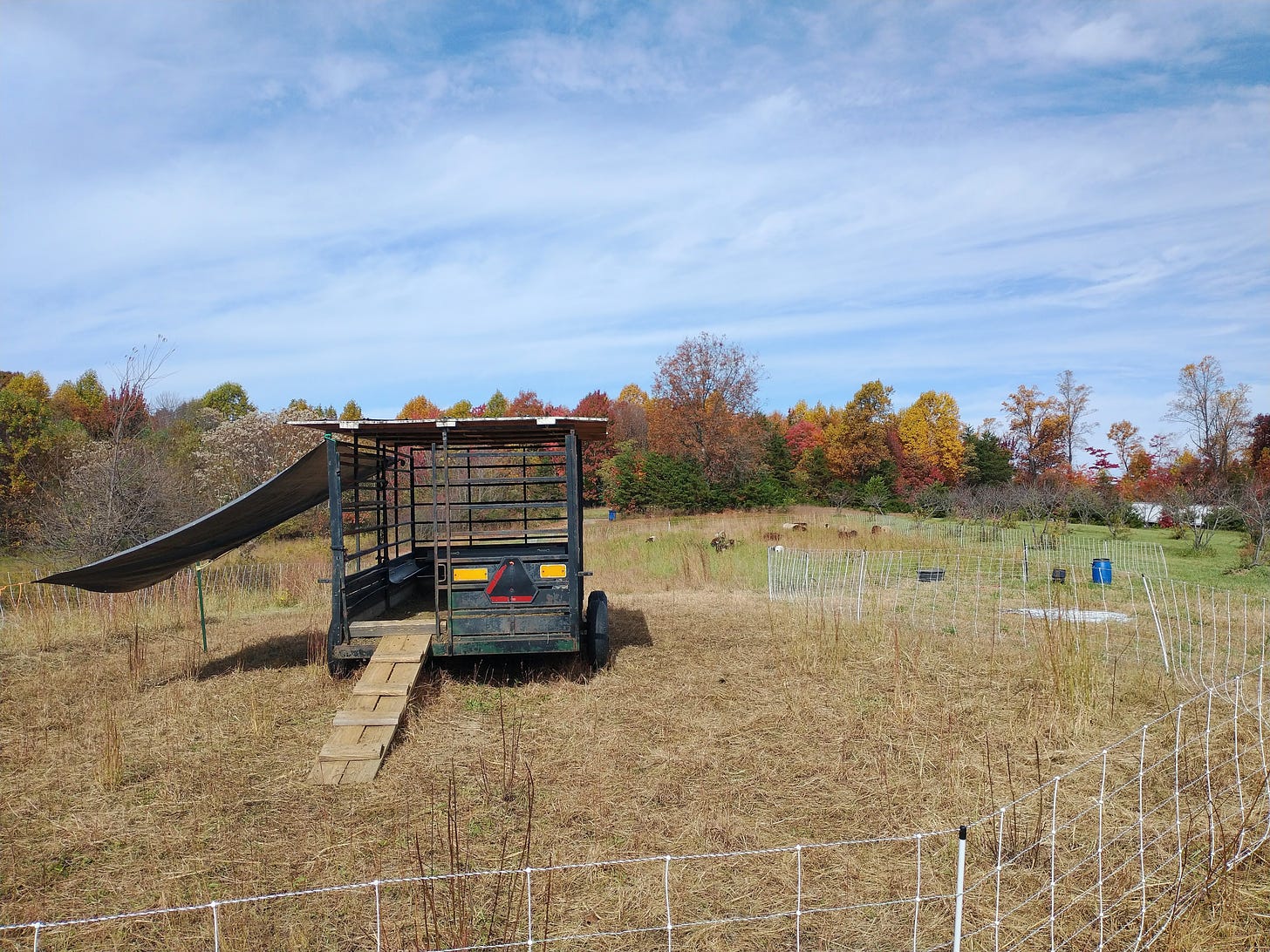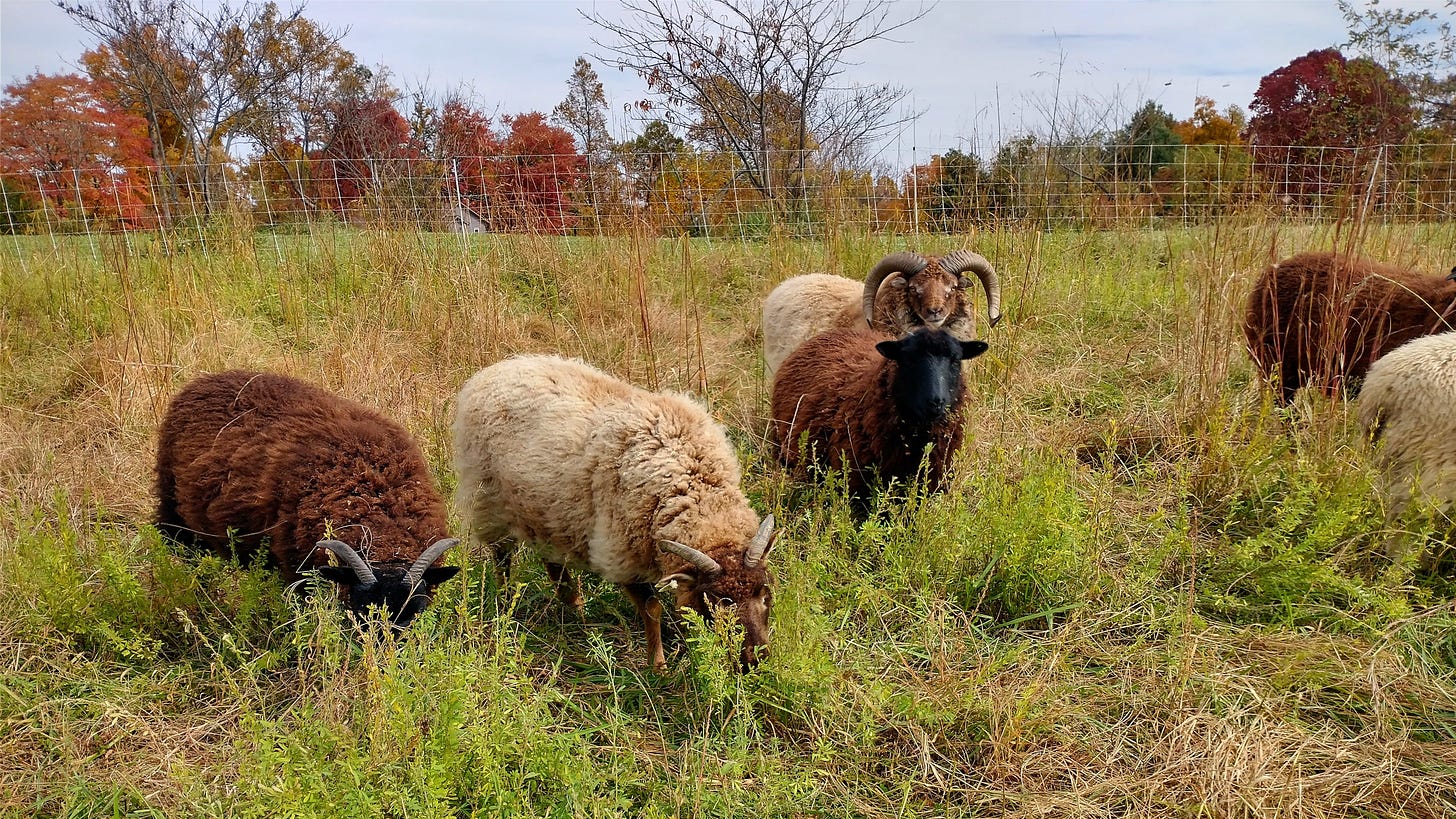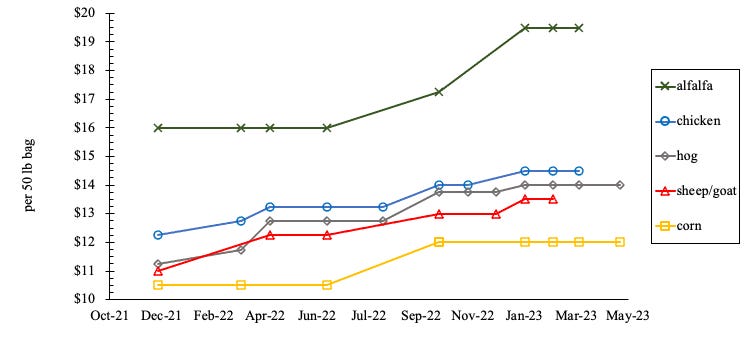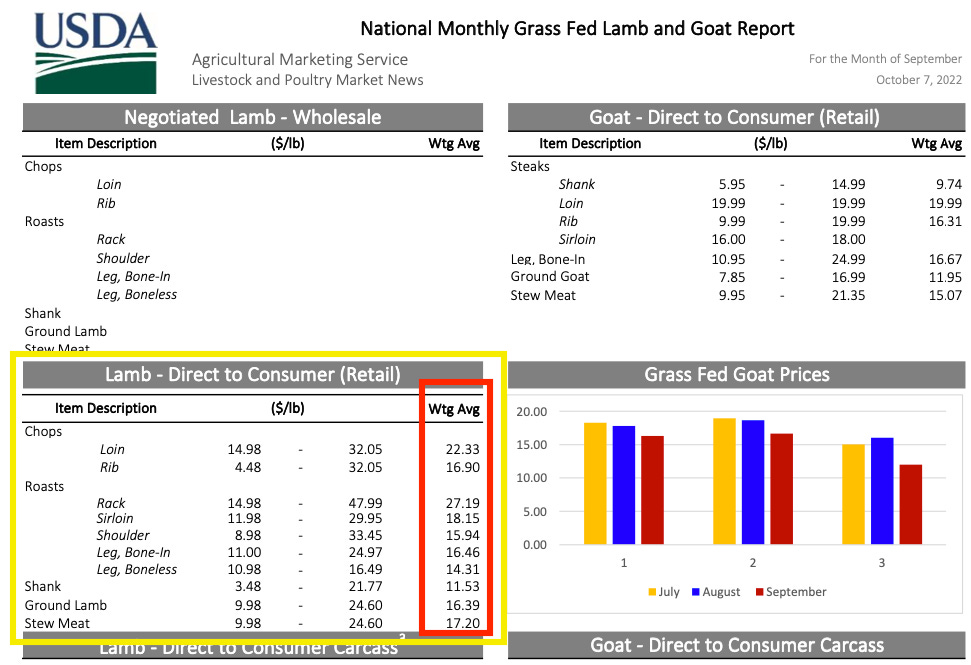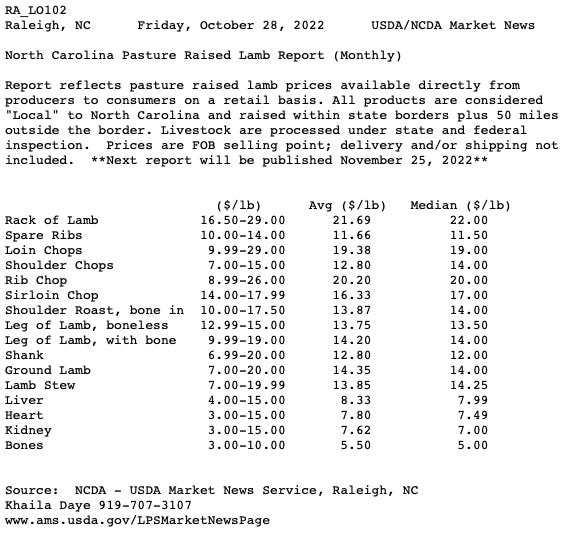Pasture raised meat prices
and how we set our prices…
We have a new simplified price scheme for 2024…
PORK - $7/lb
Our sausage has been very popular so this year that is our focus! Hot and mild country sausage, Italian sausage, bratwurst, and more!
LAMB - $16/lb
Rib chops, loin chops, leg and shoulder roasts, ground lamb burger - your choice of cut all $16/lb.
SPECIALTY ITEMS
Meat rabbits - live $20; whole, processed $30 (~3.5 lbs/package)
Goat - stew meat or sausage, $19/lb; whole ethnic/halal processing - inquire for pricing
Eggs - fresh chicken and duck eggs $5/half dozen, $8/dozen
Pure pork leaf lard - $9 pint, $5/half pint
Lamb or goat organ meat - hearts, livers, kidneys, $20/lb
Whole pig for bbq/pig-pickin’ - inquire for pricing
Please note:
Prices are subject to change, and
We almost always have sale items available at reduced prices. Call or write, come see us at the farm, or stop by our booth at the Hickory Farmers’ Market, and shop the latest specials!
You probably notice that these prices are significantly higher than what you typically pay in the grocery store. It’s a topic for another day to discuss the subsidies, distortions, externalities, unsustainability, environmental and animal welfare issues, etc., that afflict industrial food system products. In this article we just want to provide transparency about the process we use to set our prices.
Put simply, we consider our costs for raising and processing animals as well as current market prices for pasture raised meat in our county, state, and the broader US.
Cost considerations
Infrastructure
Obviously, there is some up-front investment in infrastructure for starting up a small regenerative agriculture enterprise. Our philosophy prioritizes thrift, frugality, resourcefulness, creativity, and good ol’ hillbilly engineering to minimize costs and promote efficiency.
We’ve done a lot of work to repair and repurpose dilapidated structures that were on the farm when we got it. For example, we demo’ed part of a hunter’s shack that was beyond repair and used the wood we reclaimed to convert the other part of the shack into a barn with stalls for lambing and kidding.
The barn
We built a shelter, farrowing pen, and loading system for the pigs for very low cost. Our neighbor gave us the old tin panels used for the roof. Much of the lumber came from disassembling the porch and deck of the old trailer on the property, and the poplar half-rounds we got for free from a local sawyer. The grain bin sheets used for the loading chute were leftover from a millwright job. The water tanks (which collect rainwater from the roof), previously used for soy sauce, were purchased at low cost.
Piggo central, in their forest haven
Our mobile goat and sheep shelter (the “Winnebagoat”) is made from an abandoned livestock trailer. We gave it a little TLC (tires, greased and repacked wheel bearings, light kit) and a roof. It has served us well.
We’ve been thrifty and resourceful, and our animals are very well cared for. Over time we expect (hope!) to recoup our expenses for building out farm infrastructure. That said, up-front infrastructure costs are not explicitly added as line-items in our meat prices.
Nutrition and Wellness
Animal wellness means receiving a healthy diet as well as medications (e.g., vaccines, de-worming, antibiotics to treat sick or injured animals) when needed and physical care such as shearing and hoof-trimming.
Our sheep and goats forage grass for most of their diet, and our pigs forage greenery, certain roots, acorns and walnuts, and other forest delectables, for a portion of their diet.
From January to April, when the grass isn’t growing, we feed hay purchased from a nearby farm to the sheep and goats. Sheep and goat mamas need additional nutrition during lambing/kidding season, so we feed supplemental grain and alfalfa pellets. Sheep and goats also need supplemental minerals and a salt lick year-round.
Pigs need more nutrition than they can get from forest foraging, so we feed 14% protein hog pellets to feeder pigs, and a 16% protein feed to nursing mamas and their piglets.
Parasites (worms) can be an issue. If you’ve seen skinny, sickly goats, for example, they most likely had worms.
The green plant shown in the photos below is Lespedeza. It’s often used for soil conservation, for example in areas where erosion is bad, and disturbed areas like along highways, since it grows in very poor soils and helps to stabilize the land.
Lespedeza (the plant, not the goat! Her name is Clarice…)
Lespedeza forage also has natural inherent anti-parasite properties. It’s growing in some of our pastures and we have plans for strategic seeding of more Lespedeza in key zones on the property for parasite control.
Our animals have had little to no issues with worms. On occasion we have had to use medical dewormer on a sheep or goat when they first arrive to our farm from another farm where worms are a problem. But babies born on our farm have not needed deworming, and during our Fall 2022 herd health check we did not deworm a single animal. Getting some Lespedeza in their diet and rotational grazing in general for breaking the parasite life-cycle probably explain our good luck with parasite absence in our flock.
Wellness costs for sheep, goats, and pigs also include straw and/or wood shavings for bedding for mamas and babies.
In very rough terms, we estimate feed and wellness costs of about $100 per year per sheep or goat, and about $200 per year per pig.
As I’m sure you’re aware, the costs of just about everything are going up these days. Though the Federal Reserve may peg the rate of inflation in 2022 at 7.5-8%, our feed costs have gone up 14-24% over the same period.
December 2021 - April 2023 cost trends per 50 lb bag of feed for alfalfa pellets, 16% protein layer chicken pellet feed, 14% protein hog pellets, sheep and goat pellets, and shelled corn (snack and moving assistance) from our local family-owned feed mill.
Cost increase over the period January 2022 - January 2023: corn 14%, sheep/goat feed 23%, hog feed 24%, chicken feed 18%, alfalfa pellets 22%.
Our animal processing and meat packaging is done by a nearby family-owned facility. Our processing costs are about $100 per sheep or goat, and about $200 per pig.
Thus our total estimated costs for raising and processing animals into packaged cuts are about $200-$250 per sheep or goat, and about $400-$500 per pig.
Of course, we are new at this having only been going for a little over two years. So these figures will be refined over time as our experience grows and we have more cost data to work from.
Market prices for pasture raised lamb and pork
Keeping in mind these cost estimates, we also look at what other farms are charging in our county, state, and in the US in general.
Wilkes County, NC
We have drawn a huge amount of inspiration from our friends at Sheraton Park Farms. They raise pastured meat chickens, egg layers, turkeys, rabbits, pigs, and cows. In a recent (October 2022) video, farmer Chuck identified their top-five sellers at farmers’ markets around our region. They sell chicken, eggs, and beef, which we don’t, and we sell lamb, which they don’t. But to give you an idea of what they ask for their products, here are prices for their top-five sellers.
ground beef - $9.50/lb
chicken breasts (bone in, with skin) - $11/lb
boneless pork chops - $15/lb
bacon (uncured, smoked) - $15/lb
pasture raised chicken eggs: $4-$5 per half-dozen, $7-$8 per dozen
We charge similar prices for our bone-in pork chops and bacon. They sell ground pork for around $10.50/lb, whereas we currently charge around $8/lb. So our prices are comparable or a little lower than those of Sheraton Park (certainly we are not over-charging compared to them).
Note: Our explicit aim is not to compete on price with Sheraton Park or any other pastured meat operations in our area. Our prices are lower, at least for now, because others have done more work to cultivate markets and customers where they can ask for more. With more time and experience we may be able to charge more for our products. We absolutely maintain a spirit of collaboration and cooperation with other folks doing regenerative agriculture in our region. We all win together!
State of North Carolina and US
The US Department of Agriculture (USDA) and the North Carolina Department of Agriculture (NCDA) publishes handy reports each month listing ranges and averages of retail prices for pasture raised lamb, goat, and pork (and beef, dairy, poultry, etc.).
These can be found here under the heading “Direct to Consumer.”
Very simply, we look at these reports, in particular at the average prices that different cuts of meat sell for in NC and in the broader US, and we set our prices close to these values. Sometimes NC prices are a little higher than the US average, and sometimes they are a little lower. But they are typically comparable.
Are we profitable? Are our prices fair?
The “million-dollar questions,” so-to-speak… Let’s look at some ball-park, conservative figures.
Based on our retail prices of packaged cuts, one sheep would be expected to gross about $350, and one of our kune kune pigs about $700. Subtracting the costs of raising and processing a sheep ($200-$250) or pig ($400-$500), that would net us $100-$150 per sheep, and $200-$300 per pig.
It is from those net values that we can begin to pay back our initial investments in infrastructure, and cover various other sundry costs that weren’t included in this “back-of-the-envelope” analysis.
Are our prices fair? Does this explication ease the “sticker shock” one might feel when comparing our prices to grocery store meat? Should we be charging more? That is up to you, dear reader. Let us know what you think!




